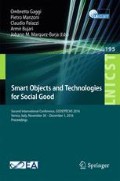Abstract
Video consumption over VANETs will increase significantly bandwidth and will occupy an important part of the overall data traffic. To decrease the load on the VANET infrastructure and reduce bandwidth taken by video, high efficiency video codecs have been developed. In this work, a benchmarking of H.265/HEVC, H.264/AVC and Google VP9 has been conducted by means of objective and subjective evaluations, assuming an urban VANET scenario. Considering a wide range of bit rates from very low to high, results show a clear advantage of HEVC with average bit rate savings of 27% when compared to VP9 and 49% when compared to AVC.
Access this chapter
Tax calculation will be finalised at checkout
Purchases are for personal use only
Notes
- 1.
The Quantization Parameter (QP) regulates how much spatial detail is saved. When QP is very small, almost all that detail is retained. As QP is increased, some of that detail is aggregated so that the bit rate drops, but at the price of some increase in distortion and some loss of quality.
- 2.
Bj\(\phi \)ntegaard Delta-Rate (BD-Rate) is the average bit rate difference in percentage for the same PSNR.
References
High efficiency video coding (HEVC). https://hevc.hhi.fraunhofer.de/. Accessed 17 May 2016
The webm project. http://www.webmproject.org/. Accessed 5 Sep 2016
Grois, D., Marpe, D., Mulayoff, A., Itzhaky, B., Hadar, O.: Performance comparison of h.265/MPEG-HEVC, vp. 9, and H.264/MPEG-AVC encoders. In: Proceedings of the Picture Coding Symposium (PCS), pp. 394–397, December 2013
Sharabayko, M.P., Markov, N.G.: Contemporary video compression standards: H.265/HEVC, vp9, vp10, daala. In: Proceedings of the International Siberian Conference Control and Communications (SIBCON), pp. 1–4, May 2016
Iza-Paredes, C., Mezher, A.M., Aguilar Igartua, M.: Evaluating video dissemination in realistic urban vehicular ad-hoc networks. In: The 19th ACM International Conference on Modeling, Analysis and Simulation of Wireless and Mobile Systems, MSWiM 2016, Malta. ACM (2016)
Iza-Paredes, C., Mezher, A.M., Aguilar Igartua, M.: Adaptive video-streaming dissemination in realistic highway vehicular ad-hoc networks. In: Performance Evaluation of Wireless Ad Hoc, Sensor, and Ubiquitous Networks, PE-WASUN 2016, Malta. ACM (2016)
H.264/avc software coordination (AVC). http://iphome.hhi.de/suehring/tml/. Accessed 17 May 2016
Derf’s dataset. https://media.xiph.org/video/derf/. Accessed 22 Mar 2016
OpenStreetMap. http://www.openstreetmap.org. Accessed 22 Mar 2015
SUMO – Simulation of Urban MObility. http://goo.gl/uvvD4N. Accessed 22 Mar 2015
Boban, M., Vinhoza, T.T.V., Ferreira, M., Barros, J., Tonguz, O.K.: Impact of vehicles as obstacles in vehicular ad hoc networks. IEEE J. Sel. Areas Commun. 29(1), 15–28 (2011)
Sommer, C., Joerer, S., Segata, M., Tonguz, O.K., Cigno, R.L., Dressler, F.: How shadowing hurts vehicular communications and how dynamic beaconing can help. IEEE Trans. Mob. Comput. 14(7), 1411–1421 (2015)
Bj\(\phi \)ntegaard, G.: Calculation of average PSNR differences between RD-curves. ITU-T SG16/Q6, Austin, Texas, USA (2001)
Hanhart, P., Ebrahimi, T.: Calculation of average coding efficiency based on subjective quality scores. J. Vis. Commun. Image Represent. 25(3), 555–564 (2014). QoE in 2D/3D Video Systems
Acknowledgments
This work was partly supported by the Spanish Government through projects TEC2014-54435-C4-1-R (INcident monitoRing In Smart COmmunities. QoS and Privacy, INRISCO) and AGAUR Information Security Group (ISG) project - 2014 SGR 1504. Cristian Iza Paredes is recipient of a grant from Secretaria Nacional de Educación Superior, Ciencia y Tecnología SENESCYT. Ahmad Mohamad Mezher is a postdoctoral researcher with the Information Security Group in the Department of Network Engineering at the Universitat Politècnica de Catalunya (UPC). Additional funding supporting this work has been granted to UPC by the Spanish Ministry of Economy and Competitiveness (MINECO) through the “Anonymized Demographic Surveys (ADS)” project, ref. TIN2014-58259-JIN, under the funding program “Proyectos de I+D+i para Jóvenes Investigadores”.
Author information
Authors and Affiliations
Corresponding author
Editor information
Editors and Affiliations
Rights and permissions
Copyright information
© 2017 ICST Institute for Computer Sciences, Social Informatics and Telecommunications Engineering
About this paper
Cite this paper
Iza Paredes, C., Mezher, A.M., Aguilar Igartua, M. (2017). Performance Comparison of H.265/HEVC, H.264/AVC and VP9 Encoders in Video Dissemination over VANETs. In: Gaggi, O., Manzoni, P., Palazzi, C., Bujari, A., Marquez-Barja, J. (eds) Smart Objects and Technologies for Social Good. GOODTECHS 2016. Lecture Notes of the Institute for Computer Sciences, Social Informatics and Telecommunications Engineering, vol 195. Springer, Cham. https://doi.org/10.1007/978-3-319-61949-1_6
Download citation
DOI: https://doi.org/10.1007/978-3-319-61949-1_6
Published:
Publisher Name: Springer, Cham
Print ISBN: 978-3-319-61948-4
Online ISBN: 978-3-319-61949-1
eBook Packages: Computer ScienceComputer Science (R0)

